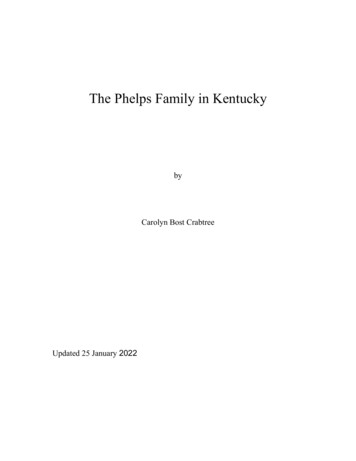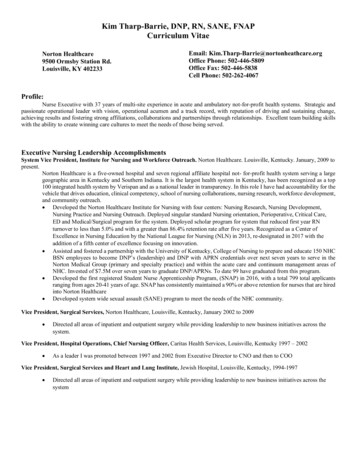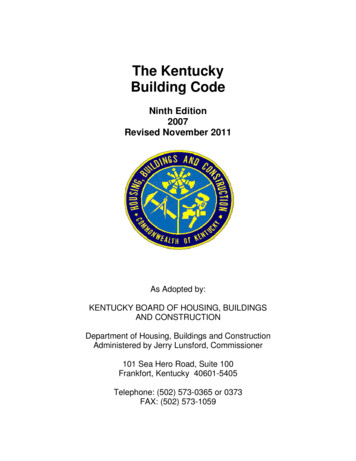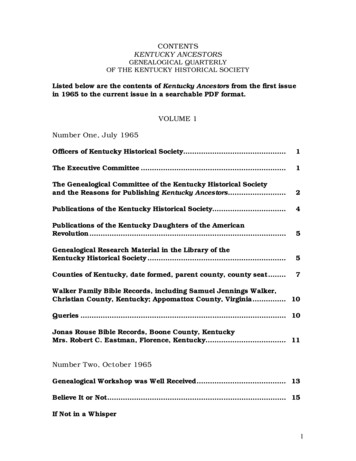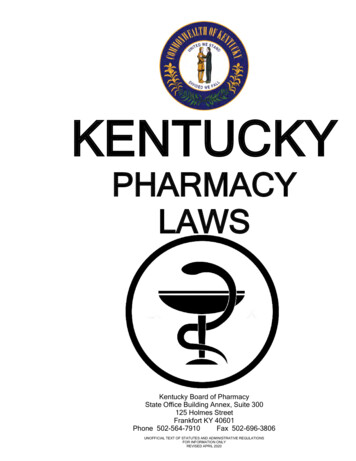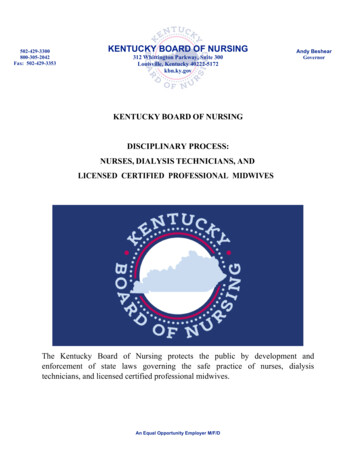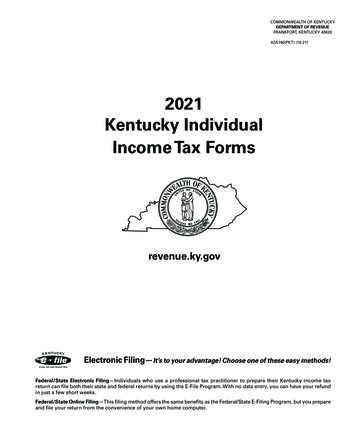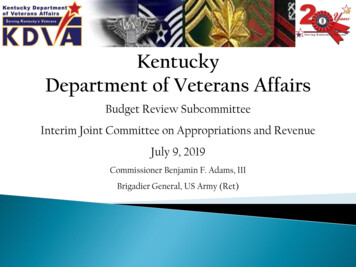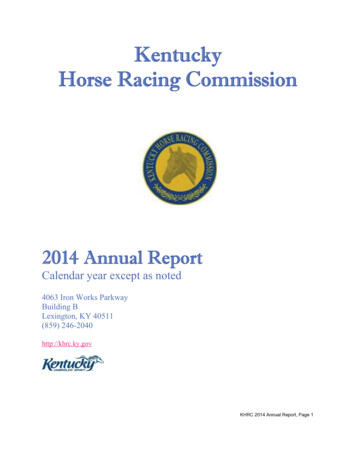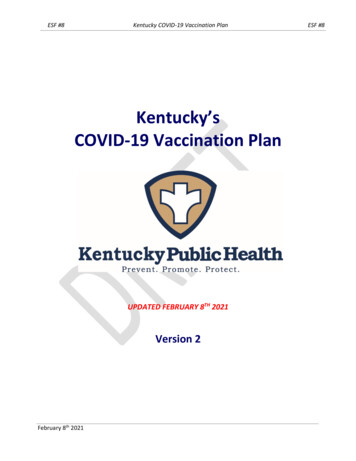
Transcription
ESF #8Kentucky COVID-19 Vaccination PlanKentucky’sCOVID-19 Vaccination PlanUPDATED FEBRUARY 8TH 2021Version 2February 8th 2021ESF #8
ESF #8Kentucky COVID-19 Vaccination PlanESF #8ContentsForeward . 2Section 1: Preparedness Planning. 3Section 2: COVID-19 Organizational Structure . 6Section 3: Vaccination Planning Phases . 8Section 4: Critical Populations . 11Section 5: Vaccination Provider Recruitment and enrollment . 18Section 6: Vaccine Administration Capacity . 20Section 7: Vaccine Allocation, Ordering, Distribution, and inventory management . 24Section 8: Vaccine Storage & Handling . 30Section 9: Vaccine Administration, documentation and reporting . 33Section 10: Vaccine Second Dose reminders . 37Section 11: imMunization information systems . 38Section 12: vaccination communication . 41Section 13: Regulatory Considerations . 44Section 14: Vaccine safety and monitoring . 46Section 15: vaccination program monitoring . 47Organization and Assignment of Responsibilites . 48Authorities and Refrences . 53Attachment 1: Vaccination Resources and Checklists . 54attachment 2: Overview of Allocation Frameworks . 56Attachment 3: Framework for Equitable Allocation of COVID-19 Vaccine . 57Attachment 4: Projected vaccination Target Groups . 59Attachment 5: Vaccine “A” Information . 62Attachment 6: Vaccine “B” Information . 65Attachment 7: Kentucky’s Interim Recommendation for. 66Allocating Supplies of COVID-19 Vaccine. 661Version 2-Final Interim Draft Kentucky’s COVID-19 Vaccination Plan
ESF #8Kentucky COVID-19 Vaccination PlanESF #8FOREWARDSARS-CoV-2, the virus that causes COVID-19, first appeared in Wuhan, China in December 2019. Since thattime, it has spread to many countries and was declared a pandemic on March 11, 2020 by the WorldHealth Organization (WHO). In order to limit the spread of COVID-19, many countries, including the UnitedStates, implemented enhanced disease surveillance and control measures such as stay at home orders toencourage physical distancing, requiring the use of facial coverings, and promoting increased handhygiene.Immunization with a safe and effective vaccine is another critical component of containing and limitingthe spread of COVID-19 related illnesses. The United States has established a goal to have enough vaccinefor all people in the United States who wish to be vaccinated. The Kentucky Department for Public Health(KDPH) is developing a plan on achieving this goal for all Kentuckians.This is the second draft version of Kentucky’s COVID-19 Vaccination Plan (Version 2.0), which builds upondraft Version 1 and incorporates the assumptions, guidance, and requirements in the Centers for DiseaseControl and Prevention (CDC) COVID-19 Vaccination Program Interim Playbook for JurisdictionOperations, issued on September 16, 2020. As additional information and guidance are available, the planwill evolve and be updated to meet the needs of all Kentuckians. Planning activities are ongoing as thetimelines and planning assumptions from Operation Warp Speed continue to evolve.2Version 2-Final Interim Draft Kentucky’s COVID-19 Vaccination Plan
ESF #8Kentucky COVID-19 Vaccination PlanESF #8SECTION 1: PREPAREDNESS PLANNINGIntroductionSince the 1970s, responding to infectious disease pandemics — predominantly those caused by theinfluenza virus — has been a recurring activity in the United States. As part of these efforts, both statesand the federal government have planned for mass distribution of vaccines and other pharmaceuticalslong before the advent of COVID-19. On an annual basis, a unique seasonal influenza (flu) vaccine ismanufactured and distributed for public consumption. As recently as 2009-2010, the H1N1 influenza virusresulted in a global pandemic necessitating the development and distribution of unique vaccines at anational scale. These prior experiences along with others for unrelated threats such as anthrax requiringmedical countermeasure distribution plans provide substantial knowledge and experience to inform theKentucky Department for Public Health’s (KDPH) COVID-19 vaccine strategy.On May 15, 2020, the Trump administration announced Operation Warp Speed (OWS) which aims to“deliver 300 million doses of a safe, effective vaccine for COVID-19 by January 2021.” OWS includes majorfederal support for the development, manufacturing, and distribution of COVID-19 vaccines, therapeutics,and diagnostics. Once a vaccine is developed, the federal government is likely to procure all availableproduct and centralize distribution to states. The algorithms for allocation are unknown at this time,but current recommendations for vaccination apportionment suggests that it be done in proportion tostate populations, as occurred during the 2009 influenza pandemic.Vaccine deployment is a multi-agency effort. The U.S. Department for Health and Human Services (HHS)is the lead agency for the federal COVID-19 response. Playing substantial support roles, the U.S.Department of Defense (DOD) has been assisting with distribution and administration of the vaccine,while the Defense Logistics Agency (DLA) is providing contract, logistics, and administrative support to thedistribution process.On July 30th, the CDC held a meeting with immunization stakeholders and outlined a general frameworkfor distribution. The announcement alludes to a distribution model similar to that used for H1N1 vaccine:industry will deliver vaccine to a central distributor from which supply states and territories will receiveweekly allocations. Vaccine administration sites – including private providers, clinics, government-runpoints of dispensing (POD), and others – will submit requests to the states who will prioritize and approvethose requests against their daily allotment. Once a request has been approved by the state, thedistribution will be made directly from the central distributor to the receiving site via contracts arrangedby the DLA. Additional direct allocations will be made to select private partners (including major retailpharmacies, names TBA) to expand access.When a vaccine is authorized for use, its supply is usually limited due to finite manufacturing capacity, theslower speed of some technologies, and the logistical challenges of distribution and administration of thevaccine. Distribution and logistics issues also have implications for other vaccines that may contribute toimproved health status. Therefore, the entire vaccine distribution system should be considered.KDPH is considering the short, medium and long-term actions necessary to lay the foundation for asmooth and orderly COVID-19 vaccination campaign. Concurrently, electronic health record vendors andimmunization information systems (IIS) are updating and preparing these data reporting systems3Version 2-Final Interim Draft Kentucky’s COVID-19 Vaccination Plan
ESF #8Kentucky COVID-19 Vaccination PlanESF #8accordingly with consideration given to target populations and phases of vaccine distribution across thehealth care system, critical population groups, and the general public.PurposeKentucky’s Vaccination Plan outlines the actions, roles, and responsibilities of state agencies andcollaborating organizations that are necessary for a smooth and orderly COVID-19 vaccination distributionand administration process. This plan primarily covers those “critical” activities that have been identifiedfor a successful COVID-19 vaccination campaign. Adjunct objectives and tasks may be added duringoperations to cover situations that arise or that are not addressed in this plan.ScopeKentucky’s Vaccination Plan is applicable to Kentucky’s COVID-19 vaccination campaign and will be usedin conjunction with the Kentucky Emergency Operations Plan (EOP), the Emergency Support Function(ESF) #8 – Public Health and Medical Services Annex, the Kentucky Medical Countermeasures (MCM) Plan,the Kentucky Disease Outbreak Support Plan (DOSP), and other relevant plans as listed in the Authoritiesand References section.Objectives Ensure timely and equitable distribution of vaccine;Provide all Kentuckians the opportunity to receive the COVID-19 vaccine;Track vaccine use across the state;Monitor vaccine safety; andEnsure access to accurate and timely information on vaccine use and availability.Planning AssumptionsPlanning assumptions are events, or circumstances that are expected to occur during an incident andaffect the operational environment of the response. The following assumptions have been made in thedevelopment of this plan:a. The efficacy of additional vaccines that may be approved/authorized is uncertain at presentand will not be known with certainty for some time.b. Vaccine will be free of cost, but administration fees may not be reimbursable while a vaccineproduct is administered under an Emergency Use Authorization (EUA).c. More than one vaccine will be available at the same time. These vaccines may have differentsafety and efficacy profiles across different population groups and may have differentlogistical requirements.d. Limited COVID-19 vaccine doses may be available in late 2020, but COVID-19 vaccine supplywill increase substantially in 2021.e. Initially available COVID-19 vaccines will either be approved as licensed vaccines or authorizedfor use under an Emergency Use Authorization (EUA) issued by the U.S. Food and DrugAdministration (FDA).f.Cold chain storage and handling requirements for each COVID-19 vaccine product will varyfrom refrigerated (2o to 8oC) to frozen (-20oC) to ultra-cold (-60o to -80o C) temperatures, and4Version 2-Final Interim Draft Kentucky’s COVID-19 Vaccination Plan
ESF #8Kentucky COVID-19 Vaccination PlanESF #8ongoing stability testing may impact these requirements. Note: Updated information will beprovided as it becomes available.g. As with other new medical treatments, post-marketing surveillance will be necessary to morefully define the long-term safety profile of approved vaccines.h. KDPH will receive a vaccine allocation based on Kentucky’s proportion of the U.S. population.i.Some of the candidate vaccines will require two doses to produce protective immunity.j.The number of healthcare personnel qualified to dispense or administer the vaccines and thenumber of volunteers available to perform support functions will limit the rate at which thevaccines can be dispensed.k. It may take many months before most U.S. residents have access to vaccination; bottlenecksat various stages of the vaccine manufacturing process (e.g., supply of vials or syringes, filland finish process) could cause further delays in vaccine availability.l.Specialized vaccine distribution systems and outreach efforts to provide access to some of thehighest-risk populations may be needed.m. Access to sufficient personal protective equipment (PPE) may be a limitation once wide scalevaccination operations take place.n. The vaccine will be distributed and administered via multiple pathways such as hospitals,medical offices, clinics, local health departments, pharmacies, and other locations.o. A portion of the U.S. population is hesitant to receive a COVID-19 vaccine.p. The CDC will provide ancillary vaccination supplies such as needles, syringes, alcohol swabs,etc.q.Prioritization decisions will occur in stages as supply increases.r.Guidance from the CDC and the Advisory Committee on Immunization Practices (ACIP) willchange, likely over a relatively short time (weeks and months). KDPH will take this guidanceinto consideration when determining phases and distribution of the vaccine.s. There will be times when supply is insufficient even for the most vulnerable populations, andKDPH will need to carefully consider how to distribute the limited supply.t.Prioritization will be based on a combination of job functions, exposure potential (i.e., hospitalpatient care workers, EMS, nursing homes), and individual risk factors for severe illness orpoor outcomes.u. Provider participation in administering the vaccine is voluntary.v. Individuals are not required by the state to receive the vaccine.5Version 2-Final Interim Draft Kentucky’s COVID-19 Vaccination Plan
ESF #8Kentucky COVID-19 Vaccination PlanESF #8SECTION 2: COVID-19 ORGANIZATIONAL STRUCTUREPlanning and Coordination TeamKentucky’s vaccination planning is a combined state and local responsibility that requires closecollaboration between KDPH, Local Health Departments (LHDs) external agencies, and communitypartners. Kentucky public health has a “shared governance” health structure within which both KDPH andLHDs will play a key roles ensuring a successful COVID-19 vaccination campaign.In May of 2020, KDPH stood up a COVID-19 Vaccination Planning Team. The current COVID-19 VaccinationPlanning Team structure follows the structure set forth in the Incident Command System (ICS) and is a“Branch” under KDPH’s COVID-19 ICS structure. The COVID-19 Vaccination Planning Team has a wide arrayof expertise and representation. Some team members represent partners (e.g. Fire, EMS, and LawEnforcement) and will serve as conduits for communication and planning assistance. Many of the teammembers involved in planning will also be involved in the execution and implementation of thevaccination plan.Figure 1 Cross-functional Planning MatrixVaccine Distribution Advisory CommitteeReaching intended vaccine recipients is essential to achieving desired levels of COVID-19 vaccinationcoverage. To ensure equitable access to vaccinations, information about populations within a jurisdictionand the logistical requirements for providing them access to COVID-19 vaccination services requirescollaboration with external entities and community partners. To facilitate equitable access, KDPHestablished a COVID-19 Vaccination Allocation Advisory Committee (VAAC). KDPH is utilizing the KentuckyHealth and Medical Preparedness Committee (HMPAC), as well as leadership from KDPH’s COVID-196Version 2-Final Interim Draft Kentucky’s COVID-19 Vaccination Plan
ESF #8Kentucky COVID-19 Vaccination PlanESF #8planning and coordination team and representatives for critical population groups identified by CDC. In2011, the CDC Public Health Emergency Preparedness (PHEP) Cooperative Agreement required fundingrecipients to establish and maintain an advisory committee(s) comprised of senior officials fromgovernmental and nongovernmental partners to integrate preparedness efforts across jurisdictions. It isadvantageous for KDPH to utilize the HMPAC because membership includes senior representatives frommultiple disciplines and partner organizations as well as community-based partners representing at-riskpopulations (individuals with disabilities and others with access and functional needs). The VAAC, an adhoc committee of the HMPAC consists of applicable HMPAC members and KDPH leadership. The VAACreviews and discusses the “CDC’s suggested COVID-19 vaccine targeting guidance” in which they advisewhether the vaccine targeting guidance should be used or if it should be modified and how, based uponKentucky’s unique circumstances. The VAAC’s recommendations are then reviewed by the Governor andthe Public Health Commissioner for final endorsement or adjustment. Further details are explained in“Section 4: Critical Populations.”Operational Coordination StructureKDPH utilizes the Kentucky Emergency Operations Plan (EOP), the ESF #8 – Public Health and MedicalServices Annex, the State Health Operations Center (SHOC) Support Plan and the Kentucky MedicalCountermeasures Distribution Plan to guide and coordinate vaccine distribution. The aforementionedplans contain detailed information on how incidents are managed and coordinated. KDPH uses these plansto coordinate, support, and/or manage vaccine operations.The SHOC serves as the base of direction, control, and coordination for Kentucky’s COVID-19 vaccinationcampaign. The SHOC works in coordination with the State Emergency Operations Center (SEOC). Theagencies and organizations identified within this plan ensures the necessary personnel and resources areavailable to achieve the operational objectives. It is expected that personnel from supporting agencieswill operate in accordance with the rules, regulations, and capabilities of their respective agency ororganization and that local governments are responsible under all applicable laws, executive orders,proclamations, rules, regulations, and ordinances for vaccination operations and response within theirrespective jurisdiction(s).KDPH is utilizing the following systems to share information and manage the COVID-19 vaccinationcampaign (where applicable): Kentucky Immunization Registry (KYIR)Vaccine Adverse Events Reporting System (VAERS)Vaccine Tracking System (VTrckS)TiberiusReadyOpWebEOCEmail7Version 2-Final Interim Draft Kentucky’s COVID-19 Vaccination Plan
ESF #8Kentucky COVID-19 Vaccination PlanESF #8SECTION 3: VACCINATION PLANNING PHASESDue to changing vaccine supply levels at various points during the COVID-19 Vaccination Program,planning should be flexible but as specific as possible to accommodate a variety of scenarios. Vaccinesupply is limited at the beginning, so in the allocation of doses, KDPH must consider vaccination providersand settings for vaccination of limited critical populations. The vaccine supply is projected to increasequickly, however, allowing vaccination efforts to be expanded to include additional critical populationsand the general public. Additionally, recommendations on the various population groups targeted forinitial doses of vaccine could change as more vaccine is available, depending on each vaccine’scharacteristics, vaccine supply, disease epidemiology, and local community factors. Populations of focusfor initial COVID-19 vaccination are: Healthcare personnel in clinical settings (inpatient, outpatient, dental, home-based) Long-term care facility/ALF staff and residents First Responders likely to be exposed to or treat people with COVID-19; K-12 school personnel Individuals 70 years of age and olderThe CDC outlines the following phases for jurisdictions to consider in planning:Phase 1a to 1b: Limited supply of COVID-19 vaccine doses availableFocus initial efforts on reaching the critical populations listed above. Ensure vaccination locations selectedcan reach populations, manage cold chain requirements, and meet reporting requirements for vaccinesupply and uptake.In Phase 1, initial doses of vaccine are distributed in a limited manner with the goals of maximizing vaccineacceptance and public health protection while minimizing waste and inefficiency. The key considerationsin planning for this phase are: COVID-19 vaccine supply will be limited; COVID-19 vaccine administration efforts must concentrate on targeted populations to achievevaccination coverage in those groups; and Inventory, distribution, and any repositioning of vaccine will be closely monitored throughreporting to ensure end-to-end visibility of vaccine doses.Enrollment activities will be prioritized for vaccination providers and settings who will administer COVID19 vaccine to Phase 1 targeted populations.Phase 1c to Phase 2: Likely larger number of vaccine doses available; Expanded vaccination capabilityFocus on ensuring access to vaccine for members of Phase 1 critical populations not yet vaccinated, extendefforts to reach the general population, and expand the vaccine provider network. Phase 2 will likelyinclude the need for additional vaccinators to staff PODs (i.e., points of distribution), contract forvaccination services, and expand professional scopes of practice (if necessary). As the supply of availablevaccine increases, distribution will expand to increase access to vaccination services to a larger population.When larger quantities of vaccine become available, we plan to conduct two simultaneous objectives: Provide equitable access to COVID-19 vaccination for target groups; and8Version 2-Final Interim Draft Kentucky’s COVID-19 Vaccination Plan
ESF #8 Kentucky COVID-19 Vaccination PlanESF #8Provide equitable access to COVID-19 vaccination for critical populations.As the supply of available vaccine increases, access to vaccination services will expand for a largerpopulation. Key considerations in Phase 1c to Phase 2 will be: COVID-19 vaccine supply will likely be sufficient to meet demand for critical populations as wellas the general public; Additional COVID-19 vaccine doses available will permit an increase in vaccination providers andlocations; A surge in COVID-19 vaccine demand is possible, so a broad vaccine administration network forsurge capacity will be necessary; and Low COVID-19 vaccine demand is also a possibility, so jurisdictions should monitor supply andadjust strategies to minimize vaccine wastage.Phase 3: Likely sufficient supply of vaccine doses to meet demandFocus on ensuring equitable vaccination access across the entire population. Monitor vaccine uptake andcoverage, and reassess strategies to increase uptake in populations or communities with low coverage.Phase 3 will begin as COVID-19 vaccine increases in wide spread availability. It is likely that COVID-19vaccine supply will equal demand and vaccine administration networks will support increased access.KDPH will: Continue to focus on equitable vaccination access to vaccination services; Monitor COVID-19 vaccine uptake and coverage in critical populations and target strategies toreach populations with low vaccination uptake or coverage; Partner with commercial and private entities to ensure COVID-19 vaccine and vaccination servicesare widely available; and Monitor supply and reposition vaccine products to minimize vaccine wastage.Phase 4: Sufficient Supply of vaccine doses to meet or exceed demandFocus on ensuring equitable vaccination access across the entire population. Target vaccine uptake inpopulations or communities with low coverage.Phase 4 will begin as COVID-19 vaccine becomes widely available and integrated into routine vaccinationprograms. It is likely that COVID-19 vaccine supply will exceed demand and vaccine administrationnetworks may shift to a routine immunization strategy.9Version 2-Final Interim Draft Kentucky’s COVID-19 Vaccination Plan
ESF #8Kentucky COVID-19 Vaccination PlanThe ACIP Example of Phase 1 & Phase 2 COVID-19 vaccination liver.pdf10Version 2-Final Interim Draft Kentucky’s COVID-19 Vaccination PlanESF #8
ESF #8Kentucky COVID-19 Vaccination PlanESF #8SECTION 4: CRITICAL POPULATIONSIdentification of Target GroupsIt is important to acknowledge that a critical difference between the current pandemic (COVID-19) and thecontext envisioned in the CDC’s “2018 guidance for pandemic influenza vaccine allocation” is not only theepidemiological differences between COVID-19 and influenza, such as the higher rates of asymptomatictransmission and fatality risk, but also that we are currently in the midst of a social justice movementacross the country.Minimizing COVID-19 illness and deaths is a primary goal of vaccination, but this is not the only dimensionof wellbeing and common good that should be considered. Health, economic stability, and socialconnection are all central to wellbeing, for both individuals and communities. Thus, promoting wellbeingand the common good involves not only promoting public health but also promoting economic and socialwellbeing. This is reflected in a statement in the CDC’s 2018 pandemic influenza vaccine allocationdocument: “The overarching objectives guiding vaccine allocation and use during a pandemic are toreduce the impact of the pandemic on health and minimize disruption to society and the economy.”The CDC’s Advisory Committee on Immunization Practices (ACIP), the National Institutes of Health (NIH),and the National Academies of Sciences, Engineering, and Medicine (NASEM) are working to determinepopulations of focus for COVID-19 vaccination and ensure equity in access to COVID-19 vaccinationavailability across the United States. CDC has established an ACIP work group to review evidence onCOVID-19 epidemiology and burden as well as COVID-19 vaccine safety, vaccine efficacy, evidence quality,and implementation issues to inform recommendations for COVID-19 vaccination policy.KDPH established a Vaccination Allocation Committee (VAC) in which the members review the CDC’srecommended target populations and adjust as necessary. The tasks for the committee include reviewingallocation priorities, and the populations that will be added successively as vaccine suppliesincrease. Among the factors that the committee is expecting to consider are: health disparities and otherhealth access issues; individuals at higher risk (e.g., elderly and those with underlying health conditions);occupations at higher risk (e.g., health care workers and essential industries); populations at higher risk(e.g., racial and ethnic groups, incarcerated individuals, and residents of nursing homes); and geographicdistribution of active virus spread. It is likely that KDPH’s recommendations for vaccine prioritization willreflect the recommendations set forth by the CDC’s advisory committee with minimal changes. KDPHrecognizes, though, the potential for alterations of these recommendations based on the evolvingepidemiology of COVID-19 and will monitor national recommendations for changes that may occur.The Advisory Committee on Immunization Practices (ACIP) Phase 1aRecommendationsThe Advisory Committee on Immunization Practices (ACIP) recommends that, when supplies of COVID-19vaccine are limited, vaccination should be offered in a phased approach. On Dec. 1st, the CDC AdvisoryCouncil on Immunization Practices (ACIP) voted to approve the recommendation of frontline healthcareworkers and long-term care facility staff & residents as priority groups to receive initial doses of vaccineonce approved by the FDA.11Version 2-Final Interim Draft Kentucky’s COVID-19 Vaccination Plan
ESF #8Kentucky COVID-19 Vaccination PlanESF #8Per ACIP, health care workers are paid and unpaid persons serving in healthcare settings who have thepotential for direct or indirect exposure to patients or infectious materials. For Phase 1a, this includesindividuals providing patient care in settings such as: Hospitals Long-term care facilities* Emergency medical services Outpatient clinics Home health care Pharmacies Public health Education (e.g., school nurses and healthcare personnel)Phased Allocation of COVID-19 Vaccines Phase 1a ACIP Meeting ucky- Phase 1aKentucky planned for very small initial allocations of vaccine when product first becomes available. ACIPrecommended 1) health care personnel and 2) residents of long-term care facilities (LTCFs) be offeredvaccination in Phase 1a of the COVID-19 vaccination program. Kentucky adopted these recommendations.KDPH recognizes the sub-prioritization approach recommended by ACIP, because initial vaccine allocationis scarce compared to the number of healthcare personnel in the state who would require vaccination,and there is expected to be a continued constrained supply environment for some months. In addition tothe sub-prioritization endorsed by ACIP, KDPH is including additional sub-prioritization categories tobetter inform providers to ensure ethical allocation of scarce vaccine.12Version 2-Final Interim Draft Kentucky’s COVID-19 Vaccination Plan
ESF #8Kentucky COVID-19 Vaccination PlanESF #8Initial allocation of vaccine in Phase 1a is being distributed to hospitals, which are responsible forvaccinating healthcare personnel, and the Pharmacy Partnership for Long-Term Care Program, which isresponsible for vaccinating residents and healthcare personnel who work in long-term care facilities.As more is known about vaccine availability, state and local health officials will be able to determine themost effective and
ESF #8 Kentucky COVID-19 Vaccination Plan ESF 8 3 Version 2-Final Interim Draft Kentucky's COVID-19 Vaccination Plan SECTION 1: PREPAREDNESS PLANNING Introduction Since the 1970s, responding to infectious disease pandemics — predominantly those caused by the

